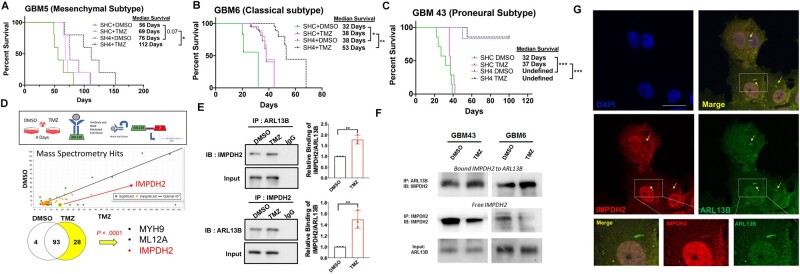Figure 4.
Loss of ARL13B increases in vivo sensitivity to TMZ and ARL13B interacts with IMPDH2 during TMZ therapy. (A–C) Kaplan-Meier curves for end point survival analysis evaluating the role of ARL13B in TMZ sensitivity. ShRNA-mediated knockdown of PDX lines (A) GBM5, (B) GBM6, and (C) GBM43. PDXs are engrafted intracranially and treated with TMZ (2.5 mg/kg) for five consecutive days beginning 7 days after tumour implantation (n = 6/group, 50% male and 50% female mice) and mice are evaluated for end point survival. (D) Schematic representing experimental flow of antibody pulldown mass spectroscopy analysis. P-values determined by Scaffold proteomics software. (E) Immunoprecipitation (IP) using anti-IMPDH2 or anti-ARL13B antibodies with an IgG control during DMSO or TMZ therapy to evaluate ARL13B IMPDH2 interaction in GBM6. Error bars represent densitometry quantification from biological triplicate immunoprecipitations. (F) Immunofluorescent co-staining with antibodies against IMPDH2 and ARL13B in the GBM6 line demonstrating the co-localization in the ciliary structure. (G) Representative immunoprecipitation experiment demonstrating the levels of free and bound IMPDH2 protein during TMZ therapy across GBM6 and 43. Samples were serially immunoprecipitated as described in the ‘Materials and methods’ section to assay free and bound forms of the protein.

